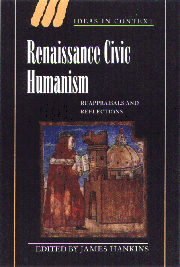Book contents
- Frontmatter
- Contents
- List of contributors
- Introduction
- 1 The republican idea
- 2 “Civic humanism” and medieval political thought
- 3 Civic humanism and Florentine politics
- 4 The two myths of civic humanism
- 5 Rhetoric, history, and ideology: the civic panegyrics of Leonardo Bruni
- 6 De-masking Renaissance republicanism
- 7 Civic humanism, realist constitutionalism, and Francesco Guicciardini's Discorso di Logrogno
- 8 Bruni and Machiavelli on civic humanism
- 9 Rhetoric, reason, and republic: republicanisms – ancient, medieval, and modern
- 10 Situating Machiavelli
- Index of manuscripts and archival documents
- General index
- Ideas in context
10 - Situating Machiavelli
Published online by Cambridge University Press: 06 October 2009
- Frontmatter
- Contents
- List of contributors
- Introduction
- 1 The republican idea
- 2 “Civic humanism” and medieval political thought
- 3 Civic humanism and Florentine politics
- 4 The two myths of civic humanism
- 5 Rhetoric, history, and ideology: the civic panegyrics of Leonardo Bruni
- 6 De-masking Renaissance republicanism
- 7 Civic humanism, realist constitutionalism, and Francesco Guicciardini's Discorso di Logrogno
- 8 Bruni and Machiavelli on civic humanism
- 9 Rhetoric, reason, and republic: republicanisms – ancient, medieval, and modern
- 10 Situating Machiavelli
- Index of manuscripts and archival documents
- General index
- Ideas in context
Summary
Of all the figures in the long, complex, and convoluted history of political thought, none is quite as difficult to situate properly as Niccolò Machiavelli. The problem is by now an old one: it bedeviled interpreters from the outset. It arises in large part because Machiavelli penned not one but two political classics and because they appear to be at odds with one another as to whether virtuous republics are decidedly and in all respects preferable to principalities governed ruthlessly in accord with the ruler's self-interest.
Machiavelli composed his Prince and his Discourses on Livy in the second decade of the sixteenth century after the collapse of the Florentine republic and the reestablishment of Medici rule. The two works circulated widely in manuscript for some time thereafter, both in Florence and abroad; and, within five years of their author's death in 1527, they were published in Rome under the imprimatur of Machiavelli's patron Clement VII, the second of the two Medici popes. Almost immediately after the appearance of these two works in printed form, an inquisitive English visitor to Florence named Reginald Pole was told by one or more of Machiavelli's compatriots that the author of the Discourses on Livy had written The Prince solely in order to trip up the Medici and bring about their demise. Machiavelli had purportedly acknowledged as much himself.
- Type
- Chapter
- Information
- Renaissance Civic HumanismReappraisals and Reflections, pp. 270 - 308Publisher: Cambridge University PressPrint publication year: 2000
- 14
- Cited by

